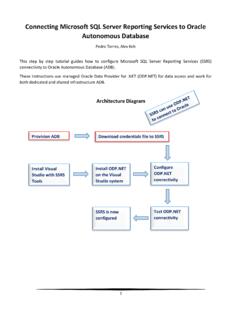Transcription of Power BI Enterprise Project Good and Best Practices
1 Power BI Enterprise Project Good and best PracticesFor designing scalable & manageable solutionsPaul @Paul_TurleyPrincipal Consultant, Pragmatic WorksSet of guidelines that address many aspects of new projects. Recommendations are applicable in most use document with ongoing revisions with the goal to provide a comprehensive, best Practices guide as the platform continues to mature and as experts continue to use NOT a 100-level introduction to Power BI NOT a technical how-to deep dive but we will discuss some technical topics Guidelines for experienced Business Intelligence & Power BI practitioners Somegoodknowledge forless-experienced PowerBIdevelopersThis Session is: I want you to ask questions Youneedtounderstandsomebasicsbeforemuch ofthiswillmakesense The topics covered in this session could be covered thoroughly in one or two weeks If the answer to your question isn t simple or within the context of this presentation, I may address it offline We can talk after the sessionSo Here s the Problem:Opportunity.
2 Bad, Good and best PracticeBad PracticeGood PracticeBetter practice exists. Has negative outcome under certain making this clear best practice may not may be multiple "good" may be a matter of preference or the best or feature is well understood and accepted in the do this for best Practice Formal projectsare scoped, funded, staffed and executed with the collaboration of a business champion and stakeholders; and IT Business Intelligence developers and data managers. These projects promote business and IT-governed datasets and certified reports. Informal projectsare executed by business users and are considered ad hoc in nature. Datasets are generally not IT governed, and reports are typically not certified. Hybrid projectscan be anything in-between. They might be a user-authored report using published, certified dataset used for self-service reporting .
3 Informal, self-service datasets can be migrated to governed datasets in collaborative IT/business TypesIT-managed BI Solution DevelopersFormal Project teams might include: Business Systems Analysts BI Solution Architects Project Managers Data Transformation (ETL) Developers Enterprise Data Modelers Measure code experts (using DAX) Report Developers Operations & Deployment EngineersAll Business Intelligence projects involve the same essential components including: Source Queries Data transformation steps Semantic data model Calculations (typically measures) Data visualizations that reside on: reports report pages dashboardsSolution ArchitectureDesktop/Free service | Web sharingPro license | Share with small groupPremium capacity | All employees Certified datasets | Self-service reportingEmbedding service | B2B SharingComposite models | AggregationsManaging Power BI Desktop Files Store in a centrally managed network-assessable folderThe storage folder should support automatic backup and recovery in the case of storage loss.
4 Report and dataset developers must open files from the Windows file systemFiles must either reside in or be synchronized with the Windows file system. Files containing imported data typically range in size from 100 to 600 MB. Any shared folder synchronization or disaster recovery system should be designed to effectively handle multiple files of this : OneDrive For Business (shared by team, with folder synchronization). SharePoint or SharePoint Online (with folder synchronization). GitHub and/or VSTS with local repository & folder synchronization. If used, Git must be configured for large file storage (LFS) if PBIX files are to be stored in the PBIX FileSSAS with Power BIPower BI Datasets Generally can have the same or more features and capabilities than SSAS data models. In Premium capacity, Power BI datasets can perform and scale as well as SSAS data models with up to 3 or 12 GB of compressed data, depending on the capacity level.
5 SSAS & AAS requires additional licensing or usage fees. These are included with Power BI licensing when using Power BI datasets. Without Premium capacity, Power BI datasets in shared capacity may not perform as well as SSAS with more than 8-10 concurrent users, or during peak usage in the shared capacity service. SSAS or AAS ensures consistent capacity and performance without Premium dedicated capacity, so it might make more sense to use SSAS or AAS when Power BI Premium capacity isn't cost-effective or with very large data volumes that exceed Premium capacity and Reports At the present time, Power BI has no integrated version control mechanism. In addition, Power BI is incompatible with most version control systems that perform branching and differencing operations on code and script files that are common in application development projects.
6 Power BI (PBIX and PBIT) report and dataset files are stored as binary archive files with internal checksum metadata. Change and differencing operations performed by most code and version management systems will corrupt these files and render them inoperable. Reality: Integrating changes made to multiple PBIX files is difficult to manage and challenging to perform technically. Even with differencing tools and effective version-control, just avoid multi-developer work on Power BI dataset files. Leverage Power BI's simplicity and don t over-engineer release management or version control. Until tooling exists to automate deployments, keep this is simple as possible. If deployment must be automated, use PowerShell to deploy datasets and reports to a workspace from a file system folder or staging workspace in the service. File versions Store the dataset and report PBIX files separately using a version number postfix for the file name in the following the For example:Manufacturing Cost Analysis Dataset Control & Lifecycle ManagementAdd aVersion Historytable to the data model by using the Enter Data feature in Power Query to create a table containing these columns: Version Number Revision Date/Time Developer Name Revision NotesVersion Control & Lifecycle Management Power BI platform currently lacks a formal process or mechanism Existingtoolsdon t work(VSTS and Azure DevOps) Release management tools are being developed but in the early stagesWorkspace and App ManagementFor a formal Project , create the following workspaces: DEV Workspace -Only development team members need Contributor access to this workspace.
7 This workspace does not need to have Premium capacity; unless, developers need to unit test incremental refresh or other Premium features. QA Workspace -All testers must have View access for testing and Contributor access for report authoring. Should be in Premium capacity to test incremental refresh. PROD Workspace -Omit the PROD designation in the name. This workspace will be the name of the published app that users will see in their Apps, Home and Favorite pages so use a name that is simple and sensible. Must have Premium capacity to share the app with non-Pro licensed script may be used to publish datasets and reports, and to change dataset bindings. It is possible to either publish to a production workspace or to effectively move assets from one workspace to another. This approach is discussed briefly in thePower BI Enterprise Deployment Guide.
8 Other approaches are discussed here: Power BI release management Build star schemas wherever possible, reshape data into fact a dimension tables with single key, one-to-many relationships from dimensions to fact. The art of dimensional modeling ranges from simple to complex. Refer to The Kimball Method for details: Enforce dimension key uniqueness Just because a key value should be unique, there is no guarantee that it will be unless enforced at the data source. Perform grouping and duplicate reduction in the data source views or Power Query queries to guarantee uniqueness. Duplicate record count checks and other mechanisms can be applied to audit source data for integrity but do not allow the data model to violate these rules. Avoid bi-directional filters and unnecessary bridging tables These data modelling patterns adversely affect performance.
9 Calculated columns Should be applied in Power Query and not in DAX calculated columns wherever possible. This maintains a consistent design pattern for maintainability. Annotate code Use in-line comments and annotations in all code including SQL, M and DAX; to explain calculation logic and provide author and revision information. Hide all fields not used directly by users. These include: primary and foreign key columns, numeric columns used to create measures, and columns used to specify the sort order of other fields. Set to Do Not Summarize Any non-hidden numeric columns that are not intended to roll-up or summarize values should be set to Do Not Summarize in the Modeling ribbon in Power BI Desktop. Columns set to summarize are indicated with a Sigma Design Avoid using SQL statements in PQ queries. Use database and tables support query folding.
10 SQL statements do not. Perform column transformations in view or PQ? use maintains the query? Remove unnecessary columns & filter rows early in the query Consolidate field renaming, removing fields and data type changes Add custom columns in Power Query instead of calculated columns in DAX, where possible Use friendly field names for all fields that won t be hidden in the data model Rename steps and add annotations in M scriptQuery OptimizationQuery Source Object(table, view, file) Power Query Query( M code produces folded source query)Data Model Table(calculations performed in DAX) Use parameters whether implementing incremental refresh or not RangeStart& RangeEndparameters must be date/time type Applyrangefilteron date/timecolumn inPower QueryManaging Dataset Size with Parameters*Incremental Refresh is a Premium featureImplicit measure = numeric field with default summarizationExplicitmeasure = Defined using DAX expression Implicit measures are typically OK in informal projects Measures should be explicitly defined in formal data models Implicit measuresdon t work in some client toolsImplicit and Explicit MeasuresNon-governed Data Teach& support analyst userstousePowerBItoacquire, mashup & model data make mistakes, get messy LillyTomlin.

